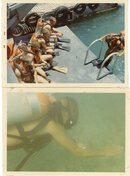I just wanted to say that I enjoy both your precision and the historical tidbits, especially the old photos.'Sorry, but I'm just being old school, U.S. Naval School for Underwater Swimmers correct. The photo shows the U.S.S. divers at one atmosphere, absolute.
SeaRat
You are using an out of date browser. It may not display this or other websites correctly.
You should upgrade or use an alternative browser.
You should upgrade or use an alternative browser.
Surface pressure
- Thread starter Storker
- Start date
Please register or login
Welcome to ScubaBoard, the world's largest scuba diving community. Registration is not required to read the forums, but we encourage you to join. Joining has its benefits and enables you to participate in the discussions.
Benefits of registering include
- Ability to post and comment on topics and discussions.
- A Free photo gallery to share your dive photos with the world.
- You can make this box go away
Still wrong.I already made that exact point. But, 100 ft / 33 ft/atm = ~3. The math is correct.
SeaRat
30m = 4ata
However, the difference between 0m and 30m is 3 atmospheres. Thus 0m is 1ata plus 3 atmospheres == 4ata
If you will go back, you will note that I differentiate between atmospheres gauge, and atmospheres absolute. Your designation of "ata" is atmospheres absolute. But your pressure gauge (depth gauge) at the surface at sea level is zero. Also, the pure math was correct. 100 / 33 = ~3Still wrong.
30m = 4ata
However, the difference between 0m and 30m is 3 atmospheres. Thus 0m is 1ata plus 3 atmospheres == 4ata
To get atmospheres absolute pressure, you need to add 1 atmosphere, which is the air pressure at the surface at sea level, which is 14.7 psi in U.S. units. This you did, and also if you'll look back, so did I.
Below are two photos of diver trainees at the U.S. Naval School for Underwater Swimmers. The top photo is in the harbor at Key West, Florida in 1967 where we as a team had to go down to the bottom with a bag full of parts, and in zero visibility as a buddy team put the parts together and bring the assembly back in the bag. The other photos is of my buddy, Bob Means, on our underwater compass swim (1500 yards, as I recall). Bob and I came up right under the flag, and right where the instructor was standing, and we were also the first team in. (Unfortunately, Bob is now deceased.) One team had to be pulled from the water, as they were swimming toward Cuba (we were hauling a float line, so the boat could keep track of us). This is where I was taught the difference between absolute pressures and gauge pressures, and the need to use absolute pressure when discussing the universal gas laws as they pertain to depth and volume.
(15) Boyle's law states that if the temperature is kept constant, the volume of a gas will vary inversely as the ABSOLUTE pressure while the density will vary directly as the pressure. In other words, if the pressure on a gas is doubled, the denisty also is doubled but the volume is decreased to one-half the original volume.
U.S. Navy Diving Manual, March 1970, page 30.
SeaRat
Attachments
- Messages
- 17,327
- Reaction score
- 13,749
- # of dives
- 100 - 199
Like you say, 30m is 3 barG, 4 BarA. 3 bar water pressure, 1 bar surface pressure. For DCS calcs, you have to consider barA.I already made that exact point. But, 100 ft / 33 ft/atm = ~3. The math is correct.
SeaRat
I have serious problems understanding how this can be confusing. Perhaps we should start being consistent about using barA (or psiA) instead of messing with barG (or psiG)?
You are not confused because you are using the metric system, which is based upon water.Like you say, 30m is 3 barG, 4 BarA. 3 bar water pressure, 1 bar surface pressure. For DCS calcs, you have to consider barA.
I have serious problems understanding how this can be confusing. Perhaps we should start being consistent about using barA (or psiA) instead of messing with barG (or psiG)?
SeaRat
Depending on your dive 500psi can be your minimum gas, meaning in an all usable strategy you would thumbIs it safe to arrive at your safety stop with only 500 psi/35 bar left in your tank? Frankly, I don't think so. And I think you should start thinking about min gas calcs.
Learning to calculate minimum gas and planning your dives according to your depth, gas consumption rate, and cylinder volume feels very empowering after being told to always hit the surface with 500 or 1000 by whichever OW instructor you were certified by.
Similar threads
- Replies
- 30
- Views
- 905
- Replies
- 25
- Views
- 1,460
- Replies
- 24
- Views
- 2,486
- Replies
- 19
- Views
- 1,561




